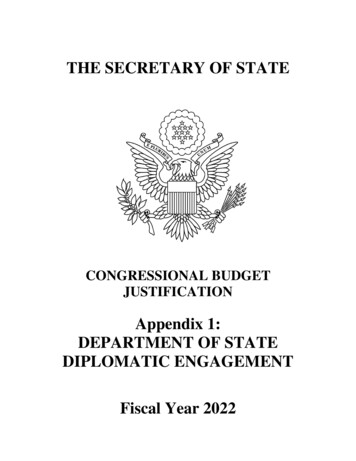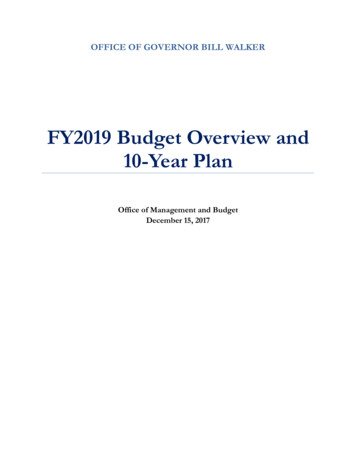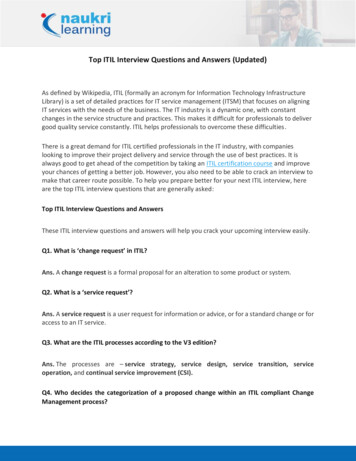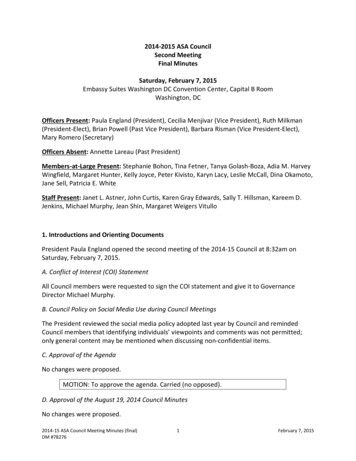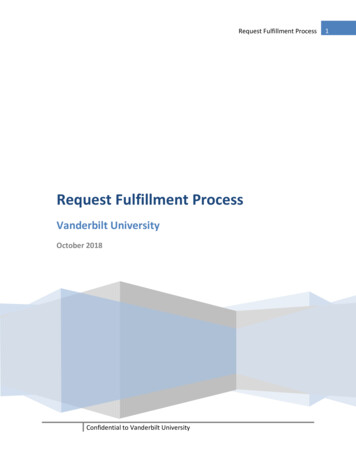
Transcription
PrefaceThe Overview Book has been published as part of the President’s Annual Defense Budget for thepast few years. From FY 1969 to FY 2005, OSD published the “Annual Defense Report” (ADR)to meet 10 USC section 113 requirements. Subsequently, the Overview began to fill this role.The Overview is one part of an extensive set of materials that constitute the presentation andjustification of the President’s Budget for FY 2019. This document and all other publications forthis and previous DoD budgets are available from the public web site of the Under Secretary ofDefense (Comptroller): http://comptroller.defense.gov.The Press Release and Budget Briefing, often referred to as the “Budget Rollout,” and theProgram Acquisition Costs by Weapons System book, which includes summary details on majorDoD acquisition programs (i.e., aircraft, ground forces programs, shipbuilding, space systems,etc.) are especially relevant.The website for Performance Improvement tables and charts rmancePlanandPerformanceReport.aspx.Other background information can be accessed at www.defense.gov.The estimated cost of this report or study for theDepartment of Defense is approximately 35,000for the 2018 Fiscal Year. This includes 12,000 inexpenses and 22,000 in DoD labor.Generated on 2018Feb02iRefID: A-6E677F4
This page intentionally left blank.ii
Overview – FY 2019 Defense BudgetTable of Contents1.Executive Summary – A Strategy Driven Budget1-12.National Defense Strategy2-1Strategic Environment . 2-1Department of Defense Objectives . 2-3Strategic Approach . 2-4Build a More Lethal Force . 2-4Strengthen Alliances and Attract More Partners . 2-7Reform the Department for Greater Performance and Affordability . 2-73.Preserve Peace through Strength3-1The Growing Threat . 3-1Power Projection . 3-4Munitions . 3-6Nuclear Modernization/Nuclear Deterrence . 3-7Missile Defense . 3-8Space and Spaced-Based Systems. 3-10Cyberspace Operations . 3-11Science and Technology . 3-12Rebuilding Service Readiness . 3-12Joint Capabilities . 3-244.Support Overseas Contingency Operations4-1Force Level Budget Assumptions . 4-2Overseas Contingency Operations Trends . 4-3OCO Functional/Mission Category. 4-45.Honoring Today’s and Future Armed Forces5-1Military Compensation . 5-2Managing the Military Health System . 5-4Strengthening Military Families . 5-5DoD Civilians . 5-76.Audit6-1The DoD Consolidated Audit Strategy . 6-2Audit Remediation . 6-3TABLE OF CONTENTSiii
Overview – FY 2019 Defense Budget7.Business Operations Reforms7-1Defense Reforms. 7-2Acquisition Reform . 7-2Cost Accounting Framework . 7-3Financial Management Reform . 7-3Contract and Management Oversight . 7-48.Military Departments8-1Army . 8-1Navy/Marine Corps . 8-7Air Force . 8-129.Performance Improvement and Agency Strategic PlanAppendix A. Resource Exhibits9-1A-1Table A-1 Combat Force Structure Overview . A-1Table A-2 Active Component End Strength (in Thousands) . A-2Table A-3 Reserve Component End Strength (in Thousands) . A-2Table A-4 DoD Base Budget by Appropriation Title . A-2Table A-5 DoD Base Budget by Military Department . A-3Table A-6 DoD OCO Budget by Appropriation Title . A-3Table A-7 DoD OCO Base Budget by Military Department . A-3Table A-8 DoD Emergency Funding by Appropriation Title . A-4Table A-9 DoD Emergency Funding by Military Department . A-4Table A-10 DoD Total (Base OCO/Emergency) Budget by Appropriation Title . A-5Table A-11 DoD Total (Base OCO/Emergency) Budget by Military Department . A-5Table A-12 DoD Base Budget by Military Department and Appropriation Title . A-5Table A-13 DoD OCO Budget by Military Department and Appropriation Title . A-7Table A-14 DoD Emergency Funding by Military Department and Appropriation Title. A-9Table A-15 DoD Total (Base OCO/Emergency) Budget by Military Department andAppropriation Title . A-11Appendix B. Acronym ListB-1TABLE OF CONTENTSiv
Overview – FY 2019 Defense Budget1. EXECUTIVE SUMMARY – A STRATEGY DRIVEN BUDGETA more lethal, resilient, and rapidly innovating Joint Force, combined with arobust constellation of allies and partners, will sustain American influence andensure favorable balances of power that safeguard the free and openinternational order.National Defense StrategyThe Department of Defense (DoD) Fiscal Year (FY) 2019 budget is the second full budget requestfrom President Trump’s administration. This budget was formulated around the National SecurityStrategy (NSS) and National Defense Strategy (NDS) goals to: Protect the American people, the Homeland, and the American way of life, Promote American prosperity, Preserve peace through strength, and Advance American influenceThe Department’s enduring mission is to provide combat ready military forces to deter war andprotect the security of the U.S., which reinforces America’s traditional tools of diplomacy. TheDepartment provides military options to ensure that the President of the United States andU.S. diplomats negotiate from a position of strength. To successfully build a strategic budgetdemands an in-depth review of all requirements, the FY 2019 budget focused on the short-termand long-term priorities that enable the Department to meet the objectives of the NSS and NDS.The NDS prioritizes major power competition, and in particular, reversing the erosion of the U.S.military advantage in relation to China and Russia. The DoD FY 2019 budget request fulfills theDepartment’s objectives by addressing Secretary of Defense direction to increase lethality;resilience; agility; build a flexible and dynamic force; and work by, with, and through allies andpartners. Guided by the NSS and NDS, the Department made specific decisions about theFY 2019 budget that support a more capable, ready, and efficient force that can project powerglobally for full-spectrum operations against a range of threats, this includes: Increasing end strength for the Army, Navy and Air Force ( 25,900), Continuing the Department's Missile Defeat and Defense Enhancement (MDDE) initiative, Increasing procurement of preferred and advanced munitions, Modernizing equipment for the second Army Armored Brigade Combat Team (ABCT), Buying ten combat ships in FY 2019, Increasing production of the F-35 aircraft and F/A-18 aircraft Enhancing deterrence by modernizing the nuclear triad Increasing funds to enhance communications and resiliency in space, Supporting U.S. Armed Forces with a pay raise of 2.6 percent, and Increasing the emphasis on technology innovation for increased lethality.CHAPTER 1EXECUTIVE SUMMARY1-1
Overview – FY 2019 Defense BudgetFigure 1.1. Department of Defense Budget( in billions)FY 2017EnactedFY 2018 CR*FY 2019RequestFY18 – FY19ChangeBase523.5523.7597.1 73.3OCO82.583.489.0 5.6--4.7---4.7606.0611.8686.1 74.2 in billionsEmergency SupplementalTotalDiscretionary budget authority.Numbers may not add due to rounding.*Reflects Continuing Resolution (CR) and Division B of Public Law 115-96 (DoD Missile Defeat and DefenseEnhancements Appropriations Act, 2018).The President’s FY 2019 budget request is for 686.1 billion. This budget represents 5 percentreal growth over the initial FY 2018 President’s Budget and 10 percent real growth over thecurrent Continuing Resolution (CR). While reversing a 7-year decline, defense spendingremains near historical lows as a share of the U.S. economy, as noted in Figure 1.2 below.Figure 1.2. Defense Outlays vs. Gross Domestic Product FY 1940 – FY 2023CHAPTER 1EXECUTIVE SUMMARY1-2
Overview – FY 2019 Defense BudgetThe U.S. military’s traditional advantages are facing new challenges in the global securityenvironment. For decades the United States has been uncontested or dominant in everyoperating domain. The United States could deploy, assemble, and operate its forces as needed.Today, all domains are contested—air, land, sea, space, and cyberspace. This more challengingthreat environment confuses the ability of U.S. forces to operate in the time and place of theirchoosing, and therefore requires more lethal, resilient, adaptable, and innovative capabilities inevery domain of warfare.This FY 2019 strategy-based budget provides the American people with detailed insight into theDepartment’s priorities as it works to enhance U.S. military capabilities. But this budget needsa timely appropriation to be fully effective. Continuing Resolutions impact the Department inmany ways, to include: postponing, delaying, and inhibiting development, procurement, andmaintenance of weapon systems; slowing the build-up of critical munition stockpiles; andintroducing the possibility of government shutdowns. Budgetary disruption and instabilitynegatively impact the Department’s ability to work efficiently and modernize rapidly.Figure 1.3. Defense Topline – a historical funding pictureCHAPTER 1EXECUTIVE SUMMARY1-3
Overview – FY 2019 Defense BudgetThis Page intentionally left blankCHAPTER 1EXECUTIVE SUMMARY1-4
Overview – FY 2019 Defense Budget2. NATIONAL DEFENSE STRATEGYThe central challenge to U.S. prosperity and security is the reemergence of long-term,strategic competition by what the National Security Strategy classifies as revisionistpowers. It is increasingly clear that China and Russia want to shape a worldconsistent with their authoritarian model—gaining veto authority over other nations’economic, diplomatic, and security decisions.National Defense StrategyThe Department of Defense’s (DoD) enduring mission is toprovide combat-credible military forces needed to deterwar and protect the security of this nation. Shoulddeterrence fail, the Joint Force is prepared to win.Reinforcing America’s traditional tools of diplomacy, theDepartment provides military options to ensure thePresident and United States diplomats negotiate from aposition of strength.The 2018 National Defense Strategy connects strategy tobudget priorities enabling the DoD to compete, deter, andwin and broadly outlines the strategy’s imperatives forredesigning the U.S. military. The reemergence of longterm strategic competition, rapid dispersion oftechnologies, and new concepts of warfare andcompetition that span the entire spectrum of conflict requirea Joint Force structured to match this reality.Sections Strategic Environment Department of DefenseObjectives Strategic Approach Build a More Lethal Force Strengthen Alliances andAttract New Partners Reform the Department forGreater Performance andAffordabilityToday, the United States is emerging from a period of strategic atrophy in which the Department’scompetitive military advantage has been eroding. The United States is facing increased globaldisorder, characterized by decline in the long-standing rules-based international order—creatinga security environment more complex and volatile than any the United States has experienced inrecent memory. Major power competition, not terrorism, is now the primary concern in U.S.national security.A more lethal, resilient, and rapidly innovating Joint Force, combined with a robust constellationof allies and partners, will sustain American influence and ensure favorable balances of powerthat safeguard the free and open international order. Collectively, a modernized Joint Force, thenew Global Operating Model and Dynamic Force Employment concept, DoD’s alliance andpartnership architecture, and Department reform will deliver relevant capabilities and the forceagility required to prevail in conflict and preserve peace through strength.The costs of not implementing this strategy are clear. Failure to meet the DoD’s objectives willresult in decreasing U.S. global influence, eroding cohesion among allies and partners, andreduced access to markets that will contribute to a decline in U.S. prosperity and standard ofliving.STRATEGIC ENVIRONMENTThe National Defense Strategy acknowledges an increasingly complex global securityenvironment, characterized by overt challenges to the free and open international order and there-emergence of long-term, strategic competition between nations. These changes require aCHAPTER 2NATIONAL DEFENSE STRATEGY2-1
Overview – FY 2019 Defense Budgetclear-eyed appraisal of the threats the United States faces, acknowledgement of the changingcharacter of warfare, and a transformation of how the Department conducts business.The central challenge to the United States prosperity and security is the reemergence of longterm, strategic competition by what the National Security Strategy classifies as revisionist powers.It is increasingly clear that China and Russia want to shape a world consistent with theirauthoritarian model—gaining veto authority over other nations’ economic, diplomatic, and securitydecisions.China is leveraging military modernization, influence operations, and predatory economics tocoerce neighboring countries to reorder the Indo-Pacific region to their advantage. As Chinacontinues its economic and military ascendance, asserting power through an all-of-nationlong-term strategy, it will continue to pursue a military modernization program that seeksIndo-Pacific regional hegemony in the near-term and displacement of the United States to achieveglobal preeminence in the future. The most far-reaching objective of this defense strategy is toset the military relationship between the United States and China on a path of transparency andnon-aggression.Russia seeks veto authority over nations on its periphery in terms of its governmental, economic,and diplomatic decisions, to shatter the North Atlantic Treaty Organization and to changeEuropean and Middle East security and economic structures to its favor. The use of emergingtechnologies to discredit and subvert democratic processes in Georgia, Crimea, and easternUkraine is concern enough, but when coupled with its expanding and modernizing nuclear arsenalthe challenge is clear.Rogue regimes such as North Korea and Iran are destabilizing their regions by pursuing nuclearweapons or sponsoring terrorism. North Korea seeks to guarantee regime survival and increasedleverage through a mixture of nuclear, biological, chemical, conventional, and unconventionalweapons and a growing ballistic missile capability to gain coercive influence over South Korea,Japan, and the United States. In the Middle East, Iran is competing with its neighbors, assertingan arc of influence and instability while vying for regional hegemony, using state-sponsoredterrorist activities, a growing network of proxies, and its missile program to achieve its objectives.The U.S. military’s traditional advantages are facing new challenges in the global securityenvironment. For decades the United States has been uncontested or dominant in everyoperating domain. The United States could deploy, assemble, and operate its forces as needed.Today, all domains are contested—air, land, sea, space, and cyberspace. This more challengingthreat environment confounds the ability of U.S. forces to operate in the time and place of theirchoosing, and therefore requires more lethal, resilient, adaptable, and innovative capabilities inevery domain of warfare.The DoD faces an ever more lethal and disruptive battlefield, combined across domains, andconducted at increasing speed and reach—from close combat, throughout overseas theaters,and reaching to the U.S. homeland. Some competitors and adversaries seek to target U.S. battlenetworks and operational concepts, while also using other areas of competition short of openwarfare.The security environment is also affected by rapid technological advancements and the changingcharacter of war. The drive to develop new technologies is relentless, expanding to more actorswith lower barriers of entry, and moving at accelerating speed. New technologies includeadvanced computing, “big data” analytics, artificial intelligence, autonomy, robotics, directedCHAPTER 2NATIONAL DEFENSE STRATEGY2-2
Overview – FY 2019 Defense Budgetenergy, hypersonics, and biotechnology—the very technologies that ensure the United States willbe able to fight and win the wars of the future.States are the principal actors on the global stage, but non-state actors also threaten the securityenvironment with increasingly sophisticated capabilities. Terrorists, trans-national criminalorganizations, cyber hackers and other malicious non-state actors have transformed global affairswith increased capabilities of mass disruption. Terrorism remains a persistent condition drivenby ideology and unstable political and economic structures, despite the defeat of ISIS’s physicalcaliphate.DEPARTMENT OF DEFENSE OBJECTIVESIt is a strategy of principledrealism that is guided byoutcomes, not ideology.National Security StrategyIn support of the National Security Strategy, theDepartment of Defense is prepared to defend thehomeland, remain the preeminent military power in theworld, ensure balances of power remain in its favor, andadvance an international order that is most conducive toU.S. security and prosperity.Long-term strategic competitions with China and Russia are the principal priorities for theDepartment, and require both increased and sustained investment -- not only to deter and ifnecessary confront aggression, but also to actively compete – because of the magnitude of thethreats each pose to U.S. security and prosperity today. Concurrently, the Department will sustainits efforts to deter and counter rogue regimes such as North Korea and Iran, defeat terrorist threatsto the United States, and consolidate the DoD’s gains in Iraq and Afghanistan while moving to amore resource-sustainable approach.Defense objectives include: Defending the U.S. homeland from attack;Sustaining Joint Force military advantages, both globally and in key regions;Deterring adversaries from aggression against U.S. vital interests;Enabling U.S. interagency counterparts to advance U.S. influence and interests;Maintaining favorable regional balances of power in the Indo-Pacific, Europe, theMiddle East, and the Western Hemisphere;Defending allies from military aggression and bolstering partners against coercion, andfairly sharing responsibilities for common defense;Dissuading, preventing, or deterring state adversaries and non-state actors fromacquiring, proliferating, or using weapons of mass destruction;Preventing terrorists from directing or supporting external operations against theUnited States homeland and its citizens, allies, and partners overseas;Ensuring common domains remain open and free;Continuously delivering performance affordably and with speed; andEstablishing an unmatched twenty-first century National Security Innovation Base thateffectively supports the Departments operations and sustains security and solvency.CHAPTER 2NATIONAL DEFENSE STRATEGY2-3
Overview – FY 2019 Defense BudgetSTRATEGIC APPROACHA long-term strategic competition requiresthe seamless integration of multipleelements of national telligence, law enforcement, and military.More than any other nation, America canexpand the competitive space, seizing theinitiative to challenge its competitors wherethe United States possesses advantagesand competitors lack strength. A morelethal force, strong alliances andpartnerships,Americantechnologicalinnovation, and a culture of performancewill generate decisive and sustained U.S.military advantages.The United States is expanding thecompetitive space, but it also offerscompetitors and adversaries an outstretched hand, open to opportunities for cooperation, but froma position of strength and based on U.S. national interests. Should cooperation fail, the DoD willbe ready to defend the American people, its values, and interests. The willingness of rivals toabandon aggression will depend on the adversary’s perception of U.S. strength and the vitality ofits alliances and partnerships.The DoD will be strategically predictable, but operationally unpredictable. Deterring or defeatinglong-term strategic competitors is a fundamentally different challenge than the regionaladversaries that were the focus of previous strategies. The strength and integrated actions of theU.S. and its allies will demonstrate the commitment to deterring aggression, but dynamic forceemployment, military posture, and operations must introduce unpredictability to adversarydecision-makers. With United States allies and partners, the DoD will challenge competitors. Tosucceed in the emerging security environment, the Department and Joint Force will have toout-think, out-maneuver, out-partner, and out-innovate revisionist powers, rogue regimes,terrorists, and other threat actors.The DoD will expand the competitive space while pursuing three distinct lines of effort: First, rebuilding military readiness as the DoD builds a more lethal Joint Force;Second, strengthening alliances as the DoD attracts new partners; andThird, reforming the Department’s business practices for greater performance andaffordability.BUILD A MORE LETHAL FORCEThe surest way to prevent war is to be prepared to win one. Doing so requires a competitiveapproach to force development and a consistent, multiyear investment to restore warfightingreadiness and field a more lethal, resilient, and agile force. The DoD aim is a Joint Force thatpossesses decisive advantages for key potential warfights, while remaining proficient across theentire spectrum of conflict.CHAPTER 2NATIONAL DEFENSE STRATEGY2-4
Overview – FY 2019 Defense BudgetAchieving peace through strength requires the Joint Force to deter conflict through preparednessfor war. During normal day-to-day operations, the Joint Force will compete to: deter aggressionin three key regions—the Indo-Pacific, Europe, and Middle East; degrade terrorist and Weaponsof Mass Destruction (WMD) threats; and defend U.S. interests from challenges below the level ofarmed conflict. In wartime, the fully mobilized Joint Force will be capable of: defeating aggressionby a major power; deterring opportunistic aggression elsewhere; and disrupting imminent terroristand WMD threats. During peace or in war, the Joint Force will deter nuclear and non-nuclearstrategic attacks and defend the homeland. To support these missions, the Joint Force must gainand maintain information superiority; and develop, strengthen, and sustain U.S. securityrelationships.The DoD must modernize key capabilities. To address the erosion of our competitive militaryadvantage, the Joint Force must become more lethal, resilient, agile, ready, and interoperablewith allies and partners. Specifically, the Joint Force must be capable of operating effectively incontested domains against highly capable adversaries. Lethal. Destroy massed enemy forces in contested domains from the outset of conflict.Resilient. Sustain operations while under sophisticated multi-domain attacks.Agile. Move quickly and unpredictably.Ready. Fight on short or no notice.Recognizing the persistent nature of terrorist threats, the Joint Force must also be able to operatecost-effectively against less sophisticated threats. To achieve these goals, the DoD must investin redesigning the Joint Force through modernized force structure – i.e., capable capacity – forcontested domains. This endeavor will require sustained, predictable budgets. The 2018National Defense Strategy is the driving logic behind DoD’s planned FY 2019-FY 2023 program,accelerating its priority capability investments in a sustained effort to solidify DoD’s competitiveadvantage. Nuclear forces. The Department will modernize the nuclear triad—including nuclearcommand, control, and communications, and supporting infrastructure. Modernizationof the nuclear force includes developing options to counter competitors’ coercivestrategies, predicated on the threatened use of nuclear or strategic non-nuclearattacks.Space and cyberspace as warfighting domains. The Department will prioritizeinvestments in resilience, reconstitution, and operations to ensure the Joint Force’sability to use space and cyberspace, even while under sophisticated multi-domainattacks. The DoD will also invest in a full suite of cyber capabilities and integrate theseinto DoD’s military planning and concept development. These investments willcontribute to deterrence by denying potential adversaries an advantage from attackingUnited States space and cyberspace assets.Command, control, communications, computers and intelligence, surveillance, andreconnaissance (C4ISR). Investments will prioritize resilient, survivable, federatednetworks and information ecosystems from the tactical up to the strategic level.Investments will also prioritize capabilities to gain and exploit information, denycompetitors those same advantages, and enable the DoD to attribute non-kineticattacks and to hold accountable adversaries attempting to exploit deniability.CHAPTER 2NATIONAL DEFENSE STRATEGY2-5
Overview – FY 2019 Defense Budget Missile defense. Investments will focus on layered missile defenses and disruptivecapabilities for both theater missile threats and North Korean ballistic missile threats.In particular, the Department will seek holistic, cost-effective solutions to counteringthe threat posed by competitors’ missile systems.Joint lethality in contested environments. The Joint Force will be able to strike diversetargets inside highly contested environments to destroy mobile power-projectionplatforms from the outset of a conflict. This includes capabilities to enhance closecombat lethality in complex terrain. Particular focus will be placed on munitions, toinclude building stockpiles of current munitions, modifying current weapons for futureconflicts, and developing future systems to ensure lasting advantage.Forward force maneuver and posture resilience. Investments will prioritize ground, air,sea, and space forces that can deploy, operate, and sustain operations in all domainswhile under attack. This will require transitioning from a peacetime posture of large,centralized, unhardened infrastructure to resilient, dispersed, smaller, adaptive basingprotected by active and passive defenses.Advanced autonomous systems. The Department will invest br
The Overview Book has been published as part of the President's Annual Defense Budget for the past few years. From FY 1969 to FY 2005, OSD published the "Annual Defense Report" (ADR) to meet 10 USC section 113 requirements. Subsequently, the Overview began to fill this role.
